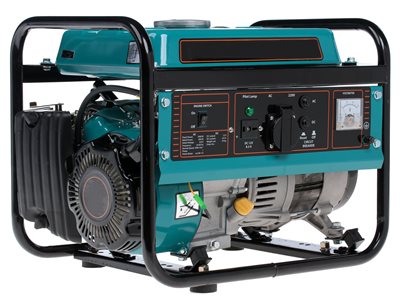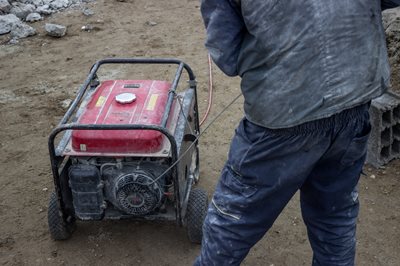Portable Generators
Portable generators are designed for maximum portability and applicability to a variety of situations. This type of equipment is sometimes called “rental grade” because they are commonly found in generator rental fleets. Unlike emergency backup generators, portable generators are expected to be run on a regular basis for prime power applications.
Portable generators come in many sizes and configurations
- Hand portable – the smallest of portable generators, from 1 kW up to 14 kW. Not the focus of this
 article but available from Generator Mart
article but available from Generator Mart
- Trailer mounted with integrated enclosure – the most common type of portable generator. These generators range from 20 kW up to 800 kW and can generally be pulled with a large pickup or work truck. Trailer mounted generators will feature a base tank that provide 8-24 hour run time.
- Power module (on trailer) – built into ISO shipping containers on a trailer chassis, power modules provide large amounts of power in a portable package. They range from 400 kW up to 2 MW. Due to size and weight restrictions, power modules may have limited run times from onboard diesel tanks.
- Vehicle mounted – in some cases, generators are mounted directly on a prime mover. While smaller units, such as a Kubota 14-kW are common, military applications may range up to 300 kW onboard. Generators are generally mounted directly to the vehicle when mobile power is needed but a trailer is impractical.
Features commonly associate with portable generators
- Mobility – Portable generators are mounted on trailers (or directly on a vehicle) to enable them to be moved between locations. When paired with an appropriate truck to pull the generator, portable equipment can be delivered to austere locations with relative ease. Heavier generators require large trucks, also influencing the hitch type.
- Multi-voltage – Voltage selector switches enable portable generators to provide the required type of power in different situations (e.g., 240V 3PH or 120 1PH). When sizing a generator, it’s important to note that voltage and number of phases can impact maximum output by 5-10%.
- Integrated fuel tank – A mobile generator needs mobile fuel. Integrated fuel tanks generally provide enough fuel to run the generator for 8-24 hours at 75% load. Fuel level limits are important to obey during movement, to avoid sloshing or overweighting the trailer.
- Weather proof – The mobile generator’s enclosure protects the engine and alternator from damage. Some portable generators are equipped with cold weather protection packages to make them capable of operations in extreme climates. Control panels typically have a weather housing to protect the sensitive electronics from moisture.
- Standalone operation – Mobile generators do not require shore power (grid power) for sustained operation, allowing them to be used where grid power does not yet exist.
- Parallel capability – Some portable generators are configured to work in parallel with other generators to produce a greater amount of electricity. This configuration allows the generators to work in concert with each other as well as carry much of the load if one generator is off line for maintenance.
- Remote state – Most portable generators are equipped with remote start connections, allowing them to be started by wire. This setup allows operators to start the generator by switch or using an Automatic Transfer Switch (ATS). Remote start and an ATS allows a portable generator to function similar to an emergency standby generator – a useful feature when a user needs to establish a backup capability in a hurry.
Use cases for portable generators
- Construction – Construction sites use portable generators to power tools and lighting prior to grid
 power connection. They prioritize durability and ability to move easily around the construction site. Some larger sites may crane generators to upper floors to support work activities.
power connection. They prioritize durability and ability to move easily around the construction site. Some larger sites may crane generators to upper floors to support work activities.
- Agriculture – Farmers and ranchers will often use portable generators to power irrigation pumps, feed tanks, and ventilation systems. They will often tow the generators over rough terrain to use locations, requiring a stout frame and enclosure.
- Oil and gas – Drill sites use generators to power petroleum extraction equipment (e.g., drills, pumps) as well as to support their workforce. Workers require lighting, water, and heating/cooling in austere environments which are generally away from grid power. Portable generators make these locations livable for long periods of time. Advanced portable natural gas generators are capable of using well head (flare) gas to power local requirements.
- Emergency backup – Portable generators can be towed to outage areas to backup critical sites or functions. During a natural disaster or sustained grid outage, organizations without permanent backup generators can rent or buy a portable generator to maintain essential capabilities. Portable generators can also support temporary camps of relief workers.
- Defense – Military-grade portable generators power temporary or mobile command and control centers. These generators power lighting, communication systems, and air conditioning unit for tent-based headquarters units.
- Backup generator maintenance – Maintenance teams regularly use portable generators as a temporary backup while maintaining critical permanent generators. This practice is common at facilities with a regulatory requirement for 100% capacity, such as large hospitals.
- Events – Temporary events such as concerts or festivals use portable generators to power sound systems, food production equipment, refrigerators, and lighting. Sound dampening for these portable generators is critical to maintaining high attendee experience. Generators are often the first part of setting up the venue, powering the equipment required to assemble sound stages or other infrastructure.
- Movie production – Remote film sets require large amounts of power for cameras, production equipment, lighting, and actor/actress housing. Similar to events, portable generators for the motion picture industry require significant sound dampening, called “studio quiet,” to prevent their sound from ending up in the final production.
Kyle Smith
| 8/25/2020 9:56:22 AM
|
0 comments